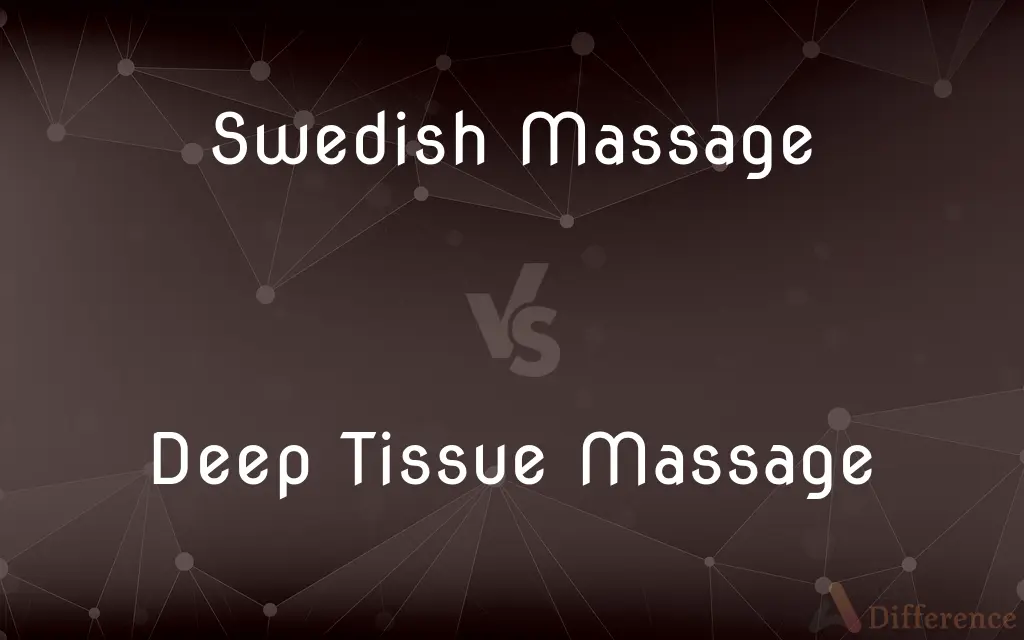Swedish Massage vs. Deep Tissue Massage — What's the Difference?
By Tayyaba Rehman & Maham Liaqat — Published on February 28, 2024
Swedish Massage focuses on relaxation and increased blood flow with lighter strokes, while Deep Tissue Massage targets muscle knots and chronic tension with firmer pressure.

Difference Between Swedish Massage and Deep Tissue Massage
Table of Contents
ADVERTISEMENT
Key Differences
Swedish Massage is designed for relaxation, employing long, gentle strokes to ease muscle tension and promote relaxation. It's known for improving blood circulation and flexibility while reducing stress. Deep Tissue Massage, however, goes deeper into the muscle and connective tissue to address chronic pain, muscle knots, and stiffness. It uses slower, more forceful strokes to target the deeper layers of muscle and fascia.
The technique used in Swedish Massage includes effleurage (long, gliding strokes), petrissage (kneading), and tapotement (rhythmic tapping). These techniques are aimed at calming the nervous system and promoting a sense of well-being. Deep Tissue Massage, on the other hand, involves techniques such as stripping (deep, gliding pressure along the muscle fibers) and friction (pressure applied across the grain of muscles). These techniques are intended to break up adhesions or "knots" that contribute to pain and restricted movement.
Swedish Massage is often recommended for those new to massage therapy or looking for a more gentle, relaxing experience. It's also suitable for individuals with sensitive skin or low pain tolerance. Deep Tissue Massage is best for individuals with chronic muscle problems, injury recovery, or those who prefer a more intense pressure to relieve deep-seated tension.
The benefits of Swedish Massage extend to stress relief, increased relaxation, and a boost in mood due to the release of endorphins. It's also beneficial for improving circulation and reducing minor muscle aches. Deep Tissue Massage offers therapeutic benefits by targeting chronic tension, facilitating muscle healing, improving posture, and increasing range of motion.
Swedish Massage is generally considered safe for most people, whereas Deep Tissue Massage may not be suitable for everyone. Individuals with certain health conditions, such as acute injuries, skin conditions, or certain cardiovascular issues, should consult with a healthcare provider before undergoing Deep Tissue Massage.
ADVERTISEMENT
Comparison Chart
Primary Focus
Relaxation and mild tension relief.
Addressing deep-seated muscle tension.
Technique
Gentle strokes like effleurage and petrissage.
Firm pressure, stripping, and friction techniques.
Intensity
Light to moderate pressure.
Firm to intense pressure.
Ideal For
Stress relief and first-time clients.
Chronic tension, pain, and injury recovery.
Benefits
Improved circulation, relaxation.
Reduced muscle knots, improved mobility.
Compare with Definitions
Swedish Massage
Ideal for stress relief.
Swedish massage is popular for its stress-relieving and relaxing benefits.
Deep Tissue Massage
Uses firm pressure.
Deep tissue massage employs firm strokes to reach deeper muscles and fascia.
Swedish Massage
Uses light to moderate strokes.
The therapist's effleurage technique during the Swedish massage felt incredibly soothing.
Deep Tissue Massage
Helps with injury recovery.
Post-accident, his recovery was aided by deep tissue massage therapy.
Swedish Massage
Suitable for beginners.
For her first massage experience, she chose the gentle Swedish massage.
Deep Tissue Massage
Aids in chronic pain relief.
She found deep tissue massage effective for her lower back pain.
Swedish Massage
Relaxation-focused massage.
She booked a Swedish massage to unwind after a stressful week.
Deep Tissue Massage
Targets deep muscle layers.
The deep tissue massage focused on his chronic shoulder tension.
Swedish Massage
Enhances blood circulation.
Regular Swedish massages helped improve his circulation and flexibility.
Deep Tissue Massage
Not recommended for all.
Due to her sensitive skin, she avoided deep tissue massage.
Common Curiosities
Who should opt for Deep Tissue Massage?
It's best for individuals with chronic pain, muscle tension, or those recovering from injuries.
Who should choose Swedish Massage?
Swedish Massage is ideal for those seeking relaxation, stress relief, or are new to massage therapy.
How often should I get a Swedish Massage?
Frequency can vary based on personal needs and goals, but many enjoy it monthly for maintenance and relaxation.
What is Deep Tissue Massage?
Deep Tissue Massage is a technique that targets deeper layers of muscle and connective tissue to relieve chronic pain and tension.
Does Deep Tissue Massage improve posture?
By addressing chronic muscle tension, it can help improve posture and flexibility.
What is Swedish Massage?
Swedish Massage is a gentle therapy focused on relaxation and reducing muscle tension with light to moderate strokes.
How do the techniques of Swedish and Deep Tissue Massage differ?
Swedish Massage uses soft, long strokes and kneading, while Deep Tissue Massage applies slow, firm strokes and pressure to target deep layers.
Can Deep Tissue Massage cause soreness?
Yes, some might experience temporary soreness or discomfort post-session due to the intense techniques used.
Are there conditions where Deep Tissue Massage is not recommended?
Yes, conditions like acute injuries, certain heart conditions, and skin diseases may require consultation before proceeding.
What should I do if I experience pain during a Deep Tissue Massage?
Inform your therapist immediately so they can adjust the technique or pressure for your comfort.
Can Swedish Massage improve health?
Yes, it can improve circulation, reduce stress, and promote relaxation, contributing to overall well-being.
Is Deep Tissue Massage painful?
It can be uncomfortable due to the intense pressure, but it shouldn't be painfully beyond a person's tolerance.
Can Swedish Massage help with anxiety?
Yes, the relaxing nature of Swedish Massage can help reduce anxiety and promote a sense of well-being.
Is Swedish Massage suitable for pregnant women?
Yes, with modifications and proper positioning, it can be safe and beneficial during pregnancy.
Can I request lighter pressure during a Deep Tissue Massage?
Absolutely, communicating with your therapist about pressure preferences is important for a beneficial experience.
Share Your Discovery

Previous Comparison
Rock vs. Alternative Rock
Next Comparison
Brown Eggs vs. White EggsAuthor Spotlight
Written by
Tayyaba RehmanTayyaba Rehman is a distinguished writer, currently serving as a primary contributor to askdifference.com. As a researcher in semantics and etymology, Tayyaba's passion for the complexity of languages and their distinctions has found a perfect home on the platform. Tayyaba delves into the intricacies of language, distinguishing between commonly confused words and phrases, thereby providing clarity for readers worldwide.
Co-written by
Maham Liaqat















































